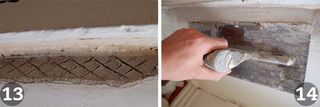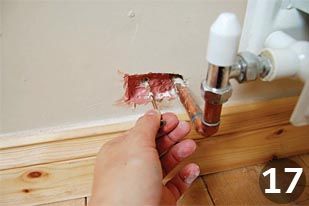How to Patch Plaster: Your Handy How-to Guide
Wondering how to patch plaster? This is one of those home maintenance jobs that will keep your home looking as fresh as the day it was decorated and patching up plaster just one task you can undertake on a DIY basis

Plaster gives a smooth finish to walls and ceilings and is hard-wearing too.Yet, over time, damage can inevitably occur as furniture gets moved around, walls knocked and the like.
In general, damage to traditionally plastered walls comes in the form of cracks, missing chunks or damaged corners, while plasterboard damage is normally limited to holes. Skimmed plasterboard can also develop hairline cracks.
One of the most common causes of damage occurs when stripping off wallpaper. You can end up with a wall that looks like its been peppered with bullets. In this case, it will be better to call in a professional plasterer skim over the whole wall — unless you are planning on papering over it.
You can expect to pay around £12/m², more if you start adding other small plaster repairs you have about your house. For these small jobs you will be better off going down the DIY route — we show you how it’s done.
Methods of Plastering
Houses built up until the end of World War II are likely to feature lath and plaster non-load-bearing/dividing interior walls and ceilings. The laths are narrow strips of wood nailed to battens that provide a key for the plaster to attach to. Load-bearing walls had plaster applied directly to the brick or stone in a series of coats.
Plasterboard became popular in the post-War period. It is sometimes skimmed with a couple of coats of plaster to give a uniform finish, or simply fixed in place and the joints taped and filled (known as dry-lining).

Equipment List
Tools
- Stanley-type knife
- Bucket for mixing plaster
- Smaller plastic pot or tray for mixing filler
- Small filler ‘knife
- Plastering float
- Hawk
- Hammer
- Chisel
Materials
- Plaster
- Powder-based filler
- Masking tape
- Builders’ ‘instant grab’ -type adhesive
- Plasterboard offcuts
- Screws
- PVA
Repairing Cracks
1. Before you start on any of the jobs below, put down a dust sheet.
2. Dig out cracks in plaster with a Stanley-type knife. You’ll need to cut in until you can no longer see the original crack. By using the blade like this you end up with a V-shaped groove which is ideal for taking the filler.

3. When you have dug the cracks out, vacuum out any dust and debris so the groove is clean.
4. For vertical and overhead filling jobs (i.e. most of them), mix the filler powder with water until it becomes a stiff paste. How stiff? We reckon its ready to use when you can do this with a filler-knife full and the filler doesn’t fall to the floor.

5. Lightly dampen the area to be filled with a plant sprayer. This helps the filler to stick.
6. Spread the filler into the groove making sure that it has gone right to the bottom. Leave the filler a little proud over the groove but remove the excess either side before the filler dries. Once dry, rub the area down with medium-grade sandpaper, then fine-grade before decorating.

How to Patch Plaster with Corner Damage

7. Damage like this is pretty common. Just applying filler and hoping for the best rarely works because gravity just drags the filler downwards. Repaired corners are also vulnerable to people walking past and knocking them. To fix a corner like this, first mix up your filler as in step four, then…
8. Apply the filler to the corner and get the shape roughly correct. Then put some wide masking tape over both sides of the corner and leave the filler to dry. The tape protects the filler and keeps it in shape. A light sanding later on will deliver the perfect corner repair. Larger areas of missing corner can be repaired using a plastering corner bead which is fixed to the wall below the level of the existing plaster and then plastered (rather than filled) up to.
How to Patch Plaster Where Chunks are Missing

9. Chunks fall out of plaster walls for a number of reasons: household clumsiness is one contributory factor, but fitting or adjusting a door frame (as here) can create a real mess. This sort of damage is best repaired with a couple of coats of plaster rather than a hit it and quit filler approach.
10. First remove any loose chunks of plaster use a hammer and chisel if necessary then vacuum out the area to get rid of the dust and debris.
11. Brush in a PVA mix to give the plaster the best possible chance of bonding with the existing wall.
12. Mix up plaster according to the manufacturer’s instructions. It should be smooth, lump free and not too runny. Next, apply a thin coat of plaster (2-3mm) onto the area to be repaired. Don’t try to fill the whole thing at once or the plaster will just dribble out of the repair.

13. When the plaster starts to dry, lightly scratch the surface with the end of the trowel in this pattern.
14. Once the first coat is dry, mix up plaster as before and use a plastering float to apply. Once the shape is correct, leave the job alone for ten minutes then wet the float and smooth the surface over

How to Patch Holes in Plasterboard

15. Holes like these are awkward to fix because there’s often a void behind the board so any filler you put in just disappears. This hole came about when a plumber couldn’t decide where to feed the pipes for a radiator. But fixing holes in plasterboard can be achieved easily…
16. Cut a piece of plasterboard that is the same width but around 25mm longer than the hole. Squeeze on some ‘instant grab’ around the edge of the board and then wind in a long screw to the centre of the repair piece.
17. Jiggle the plasterboard repair piece into the hole and hold it in place for a few seconds to give the adhesive time to ‘grab’. Once the adhesive has dried, fully apply filler on top of the plasterboard insert to bring the repair flush.

Get the Homebuilding & Renovating Newsletter
Bring your dream home to life with expert advice, how to guides and design inspiration. Sign up for our newsletter and get two free tickets to a Homebuilding & Renovating Show near you.
